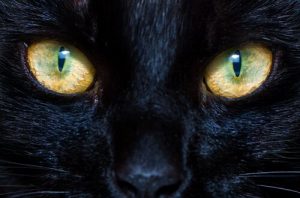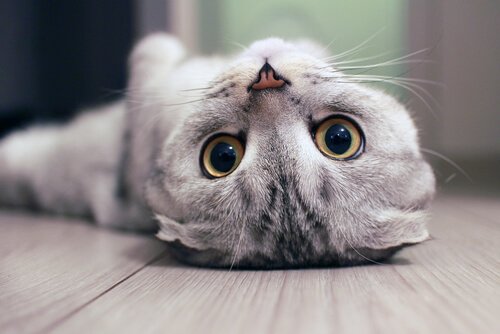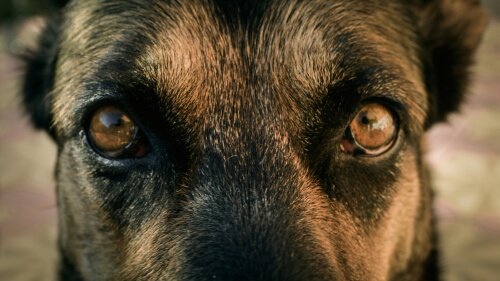Cats' and Dogs' Pupils: how they work

How cats’ and dogs’ pupils work
Cats‘ and dogs’ pupils work very differently from human pupils. The way they work, their shape, and their abilities never fail to surprise the scientific community. In this article, you can find out more about cats’ and dogs’ pupils.
Cats’ fascinating pupils
A cat‘s predatory nature is more related to the interesting vertical shape of their pupils. In 2015, a study was published in Science Advances that mentions scientists who analyzed the way pupils function for predators that hunt during the night, such as cats.

According to the study, the vertical orientation of a cat’s pupils helps them calculate the exact distance between them and their prey when there’s no sunlight out. Given that a cat’s hunting method is mainly based on surprise, this characteristic is essential for judging how high they should jump to unexpectedly pounce on their prey.
Predators that use this hunting method tend to use two techniques for calculating the distance between them and their prey:
- Using a method known as stereopsis, the brain compares the distance between two images projected on the retina of each eye. Aside from binocular vision, they send the brain the combined images in order to make a unique tridimensional image.
- This method allows animals to focus on a specific object, blurring anything in front or behind it.
The vertical nature of cats’ pupils plays an important role in stereopsis because the contours and depth of objects appear clearer in this type of pupil. However, the prey’s pupils are usually oriented horizontally.
Dogs’ pupils, more similar to ours than you might think
Just as they appear to work, dogs‘ pupils are more similar to those of humans. Canine eyes are made up of a cornea, pupil, retina, cones, and rods. Given that their eyes are on the front of their heads, their peripheral vision is a little limited.

Dog pupils react to light in the same way as our pupils do. Once the light penetrates the cornea and reaches the pupil, the pupil expands or contracts to control the amount of light that enters the eyes. Then, the light passes to the retina so that the image can be processed.
The main difference between their vision and ours lies in the reaction of the retina has to certain stimuli. While a human retina has more cones than rods, a dog’s retina is the other way around. This is why dogs have a better nocturnal vision.
Unfortunately, due to the fact that dogs have fewer cones than rods, they lack in the ability to distinguish color. Humans have three different types of cones that can absorb different wavelengths of light and thus detect more colors. A dog, on the other hand, is not able to detect colors such as green, yellow, or red.
How cats’ and dogs’ pupils work
Cats‘ and dogs’ pupils work very differently from human pupils. The way they work, their shape, and their abilities never fail to surprise the scientific community. In this article, you can find out more about cats’ and dogs’ pupils.
Cats’ fascinating pupils
A cat‘s predatory nature is more related to the interesting vertical shape of their pupils. In 2015, a study was published in Science Advances that mentions scientists who analyzed the way pupils function for predators that hunt during the night, such as cats.

According to the study, the vertical orientation of a cat’s pupils helps them calculate the exact distance between them and their prey when there’s no sunlight out. Given that a cat’s hunting method is mainly based on surprise, this characteristic is essential for judging how high they should jump to unexpectedly pounce on their prey.
Predators that use this hunting method tend to use two techniques for calculating the distance between them and their prey:
- Using a method known as stereopsis, the brain compares the distance between two images projected on the retina of each eye. Aside from binocular vision, they send the brain the combined images in order to make a unique tridimensional image.
- This method allows animals to focus on a specific object, blurring anything in front or behind it.
The vertical nature of cats’ pupils plays an important role in stereopsis because the contours and depth of objects appear clearer in this type of pupil. However, the prey’s pupils are usually oriented horizontally.
Dogs’ pupils, more similar to ours than you might think
Just as they appear to work, dogs‘ pupils are more similar to those of humans. Canine eyes are made up of a cornea, pupil, retina, cones, and rods. Given that their eyes are on the front of their heads, their peripheral vision is a little limited.

Dog pupils react to light in the same way as our pupils do. Once the light penetrates the cornea and reaches the pupil, the pupil expands or contracts to control the amount of light that enters the eyes. Then, the light passes to the retina so that the image can be processed.
The main difference between their vision and ours lies in the reaction of the retina has to certain stimuli. While a human retina has more cones than rods, a dog’s retina is the other way around. This is why dogs have a better nocturnal vision.
Unfortunately, due to the fact that dogs have fewer cones than rods, they lack in the ability to distinguish color. Humans have three different types of cones that can absorb different wavelengths of light and thus detect more colors. A dog, on the other hand, is not able to detect colors such as green, yellow, or red.
This text is provided for informational purposes only and does not replace consultation with a professional. If in doubt, consult your specialist.








